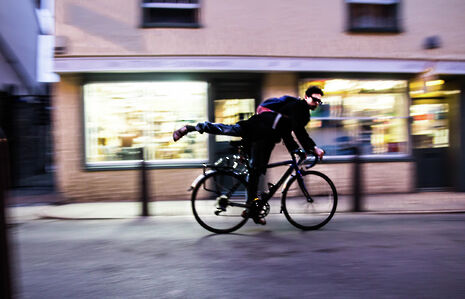Hotspots for cyclist undertaking accidents revealed
Police reports show a number of areas in which cyclists are particularly prone to accidents while attempting to undertake moving vehicles

Newly released police reports from the Department for Transport have revealed the areas in Cambridge in which cyclists are most likely to have an accident while undertaking other vehicles.
Every year, between four and five cyclists are involved in such accidents in the city, according to the reports.
The accidents recorded all involved a cyclist attempting to undertake a vehicle, though none of the accidents proved fatal. Between 2010 and 2015, there were 28 cycling accidents of this nature in Cambridge.
Magdalene Street and the junction of East Road and Broad Street by Anglia Ruskin were identified as hotspots for cycling accidents in Cambridge. These were found to be particularly hazardous areas for cyclists, with accidents occurring more frequently here than in any other area in the city. Three accidents had taken place near Magdalene Street, while four cyclists had been injured in the junction of East Road and Broad Street.
Both Magdalene Street and Broad Street are particularly narrow streets. Cyclists are vulnerable when cycling in spaces where they may be closer to other vehicles and have to make tight manoeuvres.
The accidents in question all occurred when a cyclist was undertaking a vehicle on the road. ‘Undertaking’ is when a cyclist manoeuvres past traffic on the left-hand side of a vehicle. As a move, undertaking is considered much more dangerous than overtaking, which is when a cyclist passes on the right hand side. This is because on the left side, the passenger side, a cyclist will be least visible to the driver, which is particularly dangerous when the vehicle in question happens to be a bus or a lorry. If the vehicle turns suddenly, or even shifts slightly to the left, an accident could occur.
A cyclist is particularly likely to undertake a vehicle while ‘filtering’ through traffic, the name given to the practice of moving past slow or stationary vehicles. Neither undertaking nor filtering is illegal, but the Highway Code urges caution when attempting these manoeuvres.
Cyclists are advised to undertake only when traffic is stationary, and when they are confident that it will remain stationary until they have passed the vehicles. Furthermore, it is important that cyclists do not go too fast when filtering through traffic, as they should ensure that they have enough time to predict what moves to make next.
The statistics come after findings from a recent alcohol survey in Cambridge, which revealed that 35 per cent of students said that they had cycled while drunk
 News / Night Climbers call for Cambridge to cut ties with Israel in new stunt15 April 2024
News / Night Climbers call for Cambridge to cut ties with Israel in new stunt15 April 2024 News / Police to stop searching for stolen Fitzwilliam jade17 April 2024
News / Police to stop searching for stolen Fitzwilliam jade17 April 2024 News / Cambridge University cancer hospital opposed by environmental agency12 April 2024
News / Cambridge University cancer hospital opposed by environmental agency12 April 2024 Interviews / In conversation with Dorothy Byrne1 March 2024
Interviews / In conversation with Dorothy Byrne1 March 2024 Interviews / ‘It fills you with a sense of awe’: the year abroad experience17 April 2024
Interviews / ‘It fills you with a sense of awe’: the year abroad experience17 April 2024


